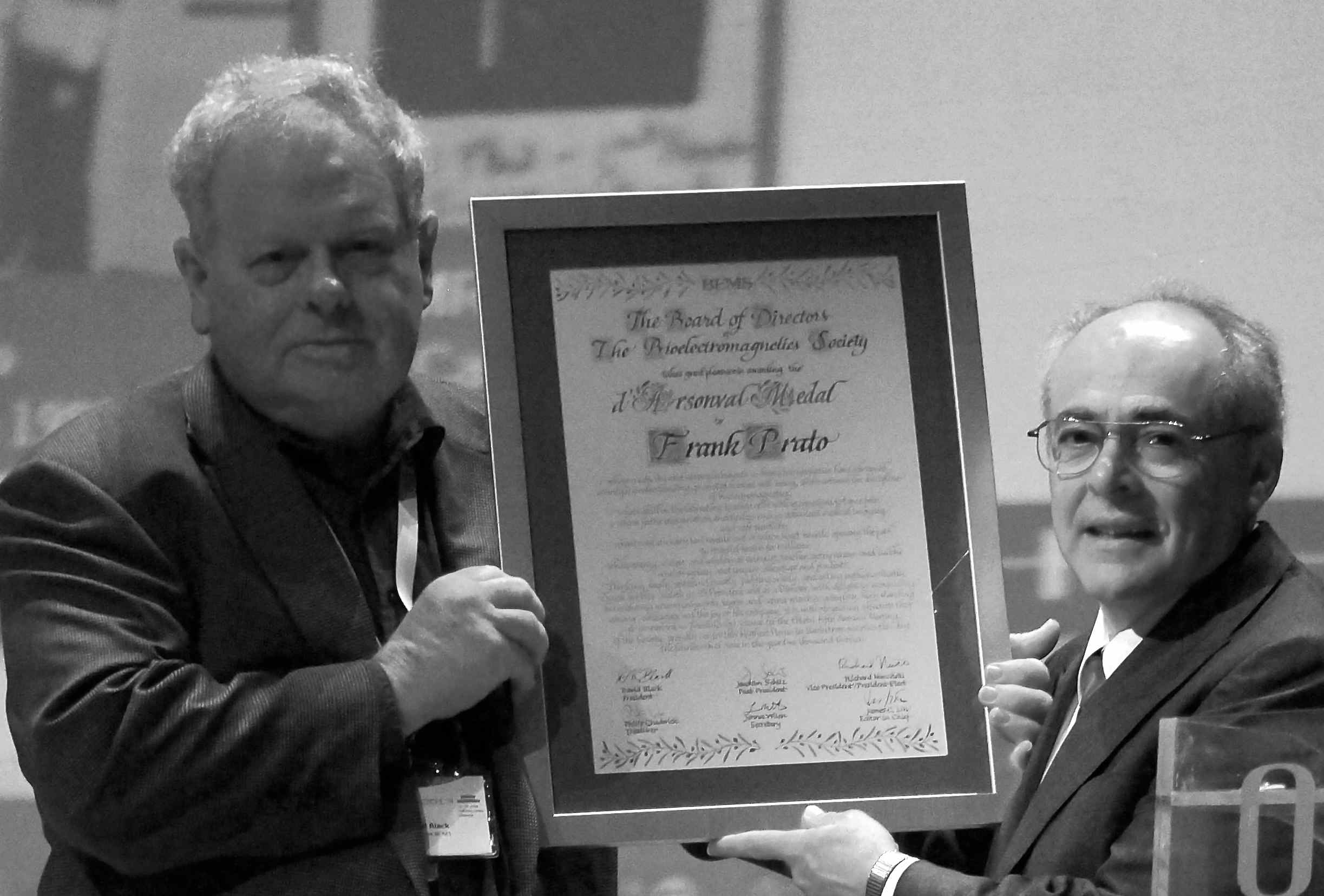The Board of Directors of The Bioelectromagnetics Society takes great pleasure in awarding the d’Arsonval Medal to Frank Prato whose creativity and accomplishments in bioelectromagnetics have advanced scientific understanding, promoted human well-being, and nurtured the discipline of bioelectromagnetics;
- whose skill in the laboratory touched cells with magnetism to tame pain;
- whose fertile imagination and tireless energy advanced medical imaging and safe practices;
- whose revolutionary tool reveals just-stricken heart muscle, opening the path to restored health for millions;
- whose energy, vision, and wisdom as scientist, teacher, entrepreneur, and builder enrich society, and inspire colleagues and students.
Thinking deeply, speaking exactly, judging wisely, and acting enthusiastically, Frank led this Society as its President and as a Director.
With delight in recognizing his enduring accomplishments, warm and caring manner, integrity, high standing among colleagues, and the joy of his company, it is with abounding affection that we, assembled in Thessaloniki, Greece for the Thirty-fifth Annual Meeting of the Society, proudly confer this Highest Honor in bioelectromagnetics this day, the fourteenth of June in the year two-thousand-thirteen.
(text composed by Asher Sheppard)

Beginning in the early 1980’s with work in nuclear magnetic imaging and MRI, Frank’s lab noticed that low frequency electromagnetic fields attenuated the analgesic effects of opioids. Intrigued, he explored whether the work of Abe Liboff in calcium cyclotron resonance might explain these effects. He recognized that models, if found to be consistent with experimental data, point the way for more productive work. His work with ion parametric resonance models developed by Valery Lednev, Charles Polk, Janie Page [Blanchard], Carl Blackman, and Stefan Engstrom helped identify key parameters influencing his results, and provided new insights about precisely how fields might influence biological systems. In time, another model evolved to form the foundation for a new company (Fralex) and a new kind of therapy for patients with chronic musculoskeletal pain. Importantly, his work reminds us of the constant dance between theoretical models and experment, expanding and developing one from the other. More recently, Frank and his students have worked with new concepts in magnetic field shielding, Image guided therapy, MRI reporter genes, and low frequency magnetic field detection with superparamagnetic iron oxide particles.
A common theme in Frank's retrospective presented at the 2013 annual meeting is collaboration with colleagues, including those he may not completely agree with. Frank's work teaches us the value of communicating in the language of science, not the rhetoric of politics, to gain greater insights through honest discussion, building on the frameworks offered by theoretical models. Charles J. Palus of the Center for Creative Leadership once wrote:
We’re all familiar with one kind of scaffolding – a temporary framework put up to give workers a place to stand when constructing a building. But there is another kind – a learning scaffold. A learning scaffold is a temporary framework of ideas that makes it possible to work on other ideas . . . The idea of learning scaffolds has many implications … but I think two are crucial. First we should be respectful of ideas and practices that we think are in error but which can give us a place to work, temporarily, on other things. Useful learning scaffolds can be wrong. Some versions of the history of science are hard on those who posited a universal fluid called ether. Yet Maxwell climbed high on this wrong idea. Second, we must learn when the time is right to discard ideas and practices that have outlived their use as scaffolding… Maxwell showed his genius by removing the learning scaffold from his finished work. Thus, ideas must be evaluated at least partly according to their utility, and not strictly according to their correctness. Developing a good sense of when to go, temporarily, with ideas we think are wrong and when to discard them could contribute significantly to innovation. [CCL, Issues and Observations, Vol. 17, No. ½, 1997]
Frank’s work has examined the value of a variety of models, each of which helped build his body of work. Building step by step, he developed experiments that teased out critical variables, making continuous improvements on our understanding of biological systems and how they behave in the presence of magnetic fields.
In response to receiving the d’Arsonval award, Frank sent the following note:
Let me begin by noting that receiving the D’Arsonval award is, for me, the most important award that I have received during the course of my career. As I noted in my acceptance speech, I couldn’t have done all that I have without the support of many students, collaborators and staff. To paraphrase Issac Newton, if I have made useful contributions in this field, it is by standing on the shoulders of giants.
I will be reviewing my scientific work in an upcoming special article in the Bioelectromagnetics Journal. But I wanted to say a few things here in the newsletter about where I see our work going. If there has been one constant in my work with my colleagues, it has been my focus on experimental protocols that allow the observation of effects during carefully controlled and well understood magnetic field exposures. Wherever possible, we’ve sought ways to extend the results of those studies to benefit humans. Of course this approach has been made possible by numerous contemporaneous advances in other areas of science and technology. Of particular interest to me were advances that allowed non-destructive and mostly non-invasive measurements to be made.
As many of you know, I have been active in The Bioelectromagnetics Society for many years, as a researcher, as a member of the Board of Directors, and as President. My vision for our bioelectromagnetics society has always been for us to play a leading role in:
- understanding the mechanisms by which magnetic fields interact with biological systems, and
- developing magnetic field based physical therapies.
Although my reach may have, in some cases, exceeded my grasp, I have certainly been able to accomplish much with dedicated help of the many collaborators, students, technical staff, and administrative support that I have had over the course of my career to date. In my many positions from researcher to instructor to mentor and as I’ve served BEMS via its governing board, I’ve gained some perspectives for what I forsee as the important future directions for our Bioelectromagnetics Society, summarized here:
Table of Seven Emerging Areas in Bioelectromagnetics
| Emerging Subject | Impact |
| Biological Effects of Wi-Fi | New wireless technology expose billions |
| Microwave Breast Imaging | Non-ionizing method to improve much needed diagnostics |
| Reconfigurable Radar Systems in Remote Sensing | Configurable antennas and radar signals (waveforms) are poised to define the next generation systems in remote sensing |
| Optical Medical Imaging Technologies | Emerging technologies allow optical signal processing not possible in the past |
| Photo-acoustic Medical Imaging Technologies | Allows advantages of optical and ultrasound to be synergistically exploited |
| Terahertz Imaging and Spectroscopy | New technologies allow generation of well characterized terahertz signals |
| Biological Effects of Extremely Low Frequency Magnetic Fields | Including MRI and the emerging areas of PET/MRI |
Some members will recognize that these are essentially an update of my earlier recommendations for the future directions of Commission K that I made while on URSI’s Long Range Planning Committee (2008 – 2011). I think they are essential to help us understand what we’ve done so far and where we can go.
But I would be remiss if I didn’t also focus on what I consider a particularly non-productive area where I think BEMS has become stuck: the unnecessary tension between some members that has polarized the debate on non-thermal effects. In my mind there is no better example than the question of whether or not the permeability of the blood brain barrier can be altered via non-thermal exposures. From my perspective, the science tells us this might very well be possible, and we need to pursue it honestly rather than become stuck in political arguments that have little basis in science. Imagine the enormous benefit that would come from being able to treat disease if we can significantly and reversibly alter the permeability of this otherwise impenetrable barrier. I wonder sometimes why we choose to limit the overall success of our society when the science is telling us that there is important work to be done.
